Let me show you how to roast a perfect prime rib, step by step, with proven, fool-proof method using reverse sear technique as seen on Serious Eats.
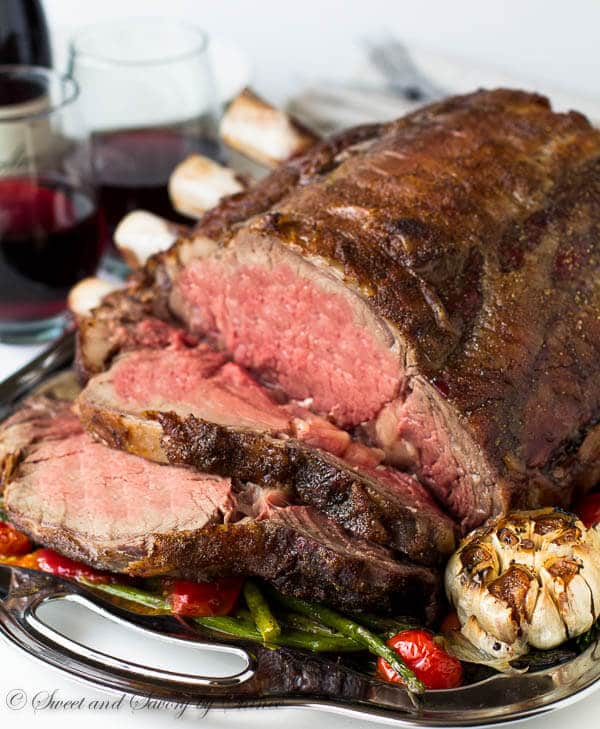
Table of Contents
- This is the Best Prime Rib recipe!
- Prime Rib Roast Ingredients
- What’s reverse searing method?
- How to cook Prime Rib
- Should you salt prime rib before cooking?
- What is the best temperature to cook a prime rib roast?
- Should prime rib be cooked covered or uncovered?
- How to serve Bone in Prime Rib
- How to store Prime Rib of Beef
- Cooking Prime Rib FAQ
- More Recipes You’ll Love
- Best Prime Rib of Beef Recipe
- If you have have a boneless prime rib, check out this post:
Oh my gosh, do I love me some prime rib!! Thick, juicy and melt-in-your-mouth tender, there is nothing better than perfectly cooked prime rib.
If you’d asked me “How would you like your steak?” like 10 years ago, when I just landed in the U.S., I’d tell you firmly, “Well done.” Cringe, cringe, I know!! Though we eat a lot of beef in Mongolia, steak isn’t common there. And we’re just not accustomed to pink meat. In fact, it took me good 2 years to start ordering medium done steaks. That’s when I met my rancher husband, who wouldn’t let me order well done (aka ruined) steaks.
Fast forward 8 years, I now cook medium and sometimes even medium rare steaks for myself. Oh how things change!
This is the Best Prime Rib recipe!
Every year at Christmas, my family serves a perfectly cooked standing rib roast with a deep brown crust and a bright red center. It’s a thing of beauty, with ooh’s and aah’s all around.
It’s intimidating to cook this expensive cut but fear not! I’m here to share a foolproof method to cook a perfect prime rib roast no matter your level of cooking expertise (or lack thereof). It’s thick, juicy, and melt-in-your-mouth tender!
- Reverse-searing method ensures even cooking
- Customize with your favorite seasoning
- Make it ahead: cook it couple of hours early and then sear it right before serving!
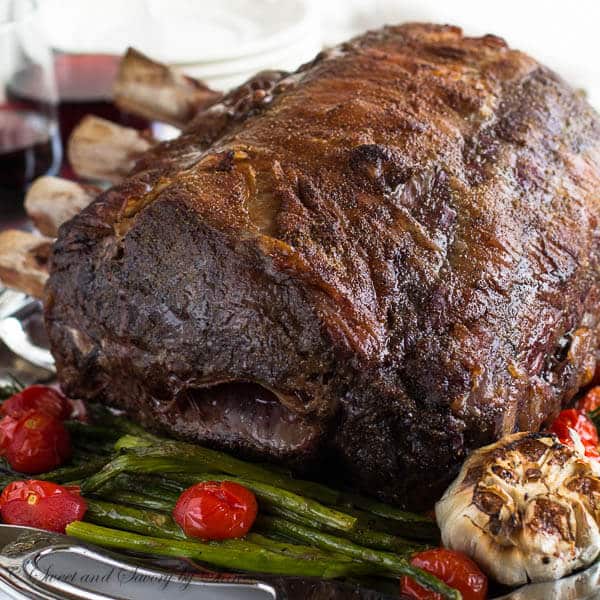
Prime Rib Roast Ingredients
- Prime rib: Prime rib is a cut from the primal rib section of the cow (hence the name). It’s also referred to as a standing rib roast, rolled rib roast, or rib-eye roast. I recommend purchasing bone-in prime rib for the best flavor and melt-in-your-mouth texture. Look for a 4-rib roast that weighs around 5 to 10 pounds. Each rib will feed 2 to 3 people, depending on the number of sides you plan to serve.
- Kosher salt: A tablespoon of salt may seem hefty but trust me on this. Salt equals flavor! And you want plenty of salt on your gorgeously crisp crust. It also ensures the interior will be succulent and not dry or tough.
- Spices: Cumin, black pepper, and garlic powder are a tasty trio, but you can use whatever spices you love! Herbs de Provence, rosemary, thyme, and sage are good options too. Or omit the spices altogether and just go with salt.
What’s reverse searing method?
When you have this beautifully marbled, perfectly frenched prime rib, you don’t want to mess up, especially if you’re making it for a special occasion. But don’t let the fear stop you from serving this masterpiece for a holiday meal. I’m going to show you a fool-proof, proven method to roast a perfect prime rib!
Now, listen read closely…
You’ve probably heard of searing the meat before roasting to lock in the juices, right? And no doubt, there’s place and time for that trusty technique, but when it comes to roasting a prime rib, that’s not really an ideal method. And I’m not just a crazy lady talking crazy things on the internet.
- Deep brown, crispy exterior.
- Minimum overcooked layer between the crust and interior, aka gray zone.
- Maximum juiciness.
He achieved all three criteria by reverse searing method. What is reverse searing, you ask?
Well, that’s when you cook the prime rib at the very low temperature until it reaches 120°F for medium rare, and then you roast it at the very high temperature for a short period of time. But here’s the important part: before searing at high temp, you’ll need to take the roast out of the oven and let it rest while oven is preheating to 500°F. This way, the roast won’t overcook, because as you know, it takes at least 20 minutes to heat an oven to that high temp, plenty of time to ruin a good roast!
How to cook Prime Rib
- The night before:
- Unwrap the prime rib and place it on a tray that will fit in your fridge. Generously salt all over the roast and refrigerate it, uncovered, overnight to air-dry the outside of the prime rib. This is crucial step for 2 reasons: salt will penetrate deep into the roast during this time and the roast will dry out and develop a nice crust.
- Prepare:
- Preheat the oven to 200°F (95°C).
- Mix the cumin, black pepper and garlic powder and evenly spread all over the meat.
- If roasting garlic, slice the top off, drizzle some olive oil and wrap in foil.
- Roast:
- Place the prime rib on a roasting pan, bone-side down.
- Roast the meat in the oven until the center of the roast reads 120°F (50°C) on a meat thermometer for medium-rare, or 130°F (55°C) for medium doneness, about 3.5-4 hours. It’s crucial to temp your roast! If you simply go by length of time in the oven, you may overcook it.
- Rest:
- Remove the prime rib from the oven, cover with foil, and let it rest for at least 30 minutes or up to 2 hours.
- Sear:
- Increase the oven temperature to 500°F (260°C).
- Uncover the prime rib and put it back into the oven. Cook it until it’s deep brown, and crisp on the outside, about 6-10 minutes. If desired, roast the cherry tomatoes and asparagus together.
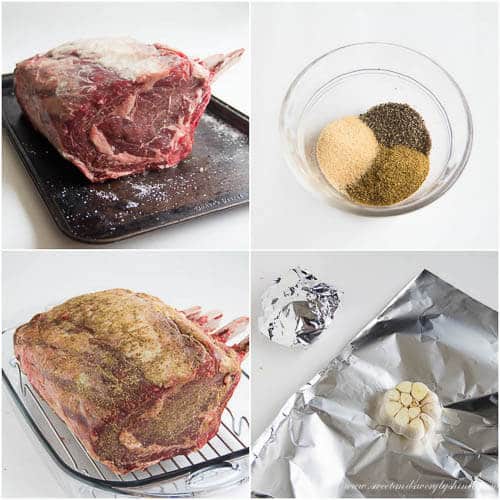
Tip
For perfectly crispy crust, make sure to dry out the roast by resting it uncovered in the fridge overnight.
And while at it, go ahead and salt it too, so that it has plenty of time to penetrate the meat all the way inside.
Should you salt prime rib before cooking?
It’s crucial to liberally salt the prime rib before you plan to cook it. It does more than just add flavor. It draws moisture to the surface of the meat which dissolves the salt. Why does this matter? It ensures the center will be juicy and not dry! It acts like a brining liquid without sacrificing the crispy exterior. The moisture reabsorbs into the meat and leaves you with a flavorful, tender roast.
What is the best temperature to cook a prime rib roast?
I highly recommend medium-rare for the best prime rib! It will be tender and juicy at this stage. If it’s overcooked, it will taste dry, tough, and chewy. I wouldn’t recommend cooking it past medium. For a medium-rare roast, cook to an internal temperature of 120 degrees. The roast’s temperature will continue to rise as you pull it out of the oven, and you don’t want it to overcook.
Should prime rib be cooked covered or uncovered?
Prime rib should be cooked uncovered. In this reverse-sear method, the roast is cooked at a low oven temperature, then “seared” at 500 degrees until crisp and deep brown. You don’t want to hinder the hot heat from crisping the crust.
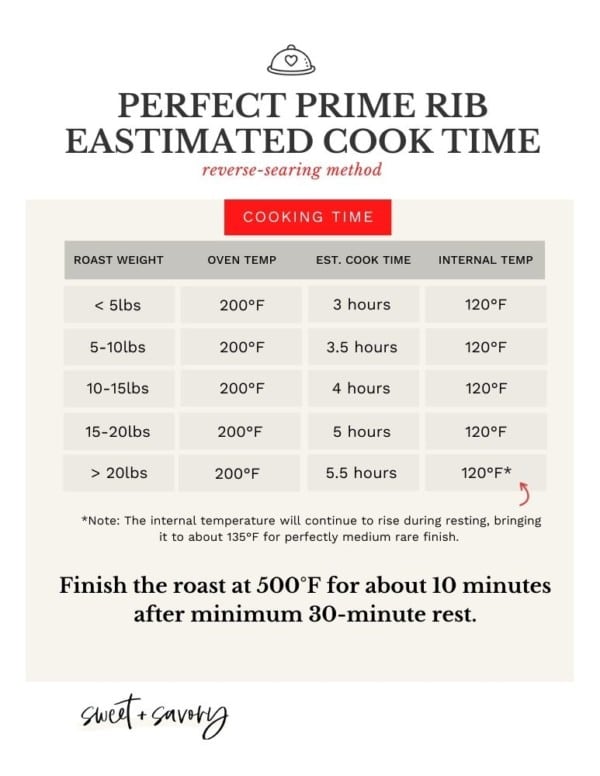
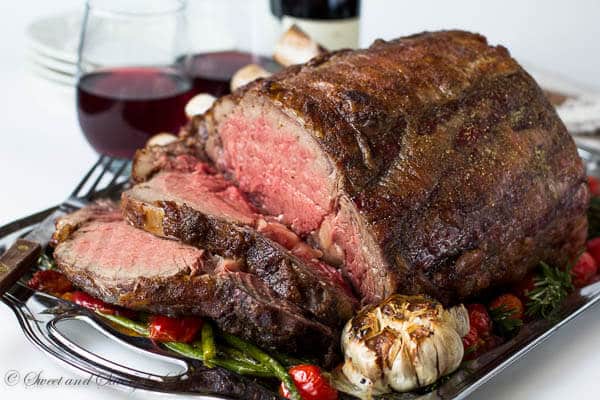
How to serve Bone in Prime Rib
The table is set, the roast is done, and your guests are salivating! Now what? It’s time to cut the roast into slices and serve. You can estimate 2 people per pound for a large portion, or 3 people per pound for a small portion.
I like to err on the side of caution and guestimate 2 people per pound. However, if you have enough sides to feed an army, you may be fine with more.
How to carve the roast
- Find a stable and large cutting board that fits the entire roast. If your cutting board slides around, place a towel underneath it to stabilize it.
- First use a boning knife to remove the bones. Hold the roast by the bones with one hand and carefully slide the boning knife directly behind the bones. Cut all the way done until the bones release from the meat.
- Lay the roast on the cutting board and use a sharp chef’s knife or santoku to slice the roast into ½ inch thick slices.
- Transfer the slices onto a serving platter and enjoy!
How to store Prime Rib of Beef
Wrap leftover prime rib in plastic wrap and refrigerate for up to 5 days. If possible, leave the leftover roast unsliced and slice before you plan to serve it.
Reheat the roast in the oven at 250 degrees. Place the roast in a baking dish, add a splash of beef broth, and cover. Cook until the roast or slices are reheated through.
If you don’t mind losing the rosy interior, you can microwave the prime rib until hot.
Cooking Prime Rib FAQ
It depends on the size of your roast and the accuracy of your oven! It’s best to temp the roast so you don’t accidentally overcook it. A 4-rib roast took approximately 3.5 to 4 hours to come to an internal temperature of 120 degrees Fahrenheit (medium-rare). It will take even longer to reach medium.
Prime rib and a rib roast are both cut from the primal rib section, specifically the 6th through 12th ribs. Prime rib has the bones intact and in a rib roast they are removed. The rib roast is often cut into ribeye steaks for grilling.
You can count on one pound of bone-in prime rib roast serving two adults. That’s about one bone per two adults, so a 4-rib prime rib serves about 8 people. If you have plenty of side dishes or light eaters, you can stretch it to 3 people per pound of meat.
Both are delicious! I recommend bone-in prime rib though because it’s harder to overcook. The bones insulate the meat for a juicy and tender finish. The main benefit to a boneless prime rib is it’s easy to carve.
They are both from the primal rib section of the cow, but a prime rib is a large roast made up of 4 to 7 ribs. If you cut the roast into steaks, then you would have ribeye’s! A prime rib is roasted whole in the oven, typically on low heat, then sliced. A ribeye is already cut into an individual steak and is grilled or seared over high heat.
Let me know if you try this method. I know you won’t regret it.
Thank you for reading!
More Recipes You’ll Love
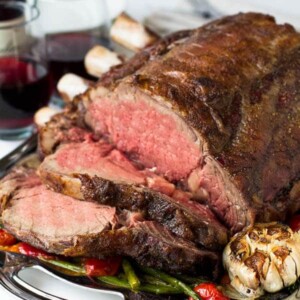
Best Prime Rib of Beef
Ingredients
- 5-10 lbs (or 4-rib) prime rib
- 1 tablespoon coarse kosher salt
- 2 teaspoons ground cumin
- 1 teaspoon ground black pepper
- 1 teaspoon garlic powder
Optional Add-Ins:
- A head of garlic
- Cherry tomatoes
- Asparagus
Instructions
Prep:
- Place an unwrapped prime rib on a tray. Generously salt all over and refrigerate overnight to air-dry the outside of the prime rib.
- Bring the prime rib to room temperature before roasting. It usually takes about 2 hours out on the counter.
- Mix the cumin, black pepper and garlic powder and evenly spread all over the meat.
- If roasting garlic, slice the top off, drizzle some olive oil and wrap in a foil. (Here's my detailed roasted garlic recipe.)
Roast:
- Preheat the oven to 200°F (95°C).
- Place the prime rib on a roasting pan bone side down (fat side up). (Since I wrote this post, I bought this roasting pan, and highly recommend it.)
- Roast the meat in the oven until the center of the roast reads 120°F (50°C) on a meat thermometer for medium-rare, or 130°F (55°C) for medium doneness, about 3.5-4 hours. (This Thermapen Mk4 meat thermometer is my favorite! Super quick and reliable! <- affiliate link)
Rest:
- Remove the prime rib from the oven, cover with a foil and rest for about 30 minutes.
Sear:
- Increase the oven temperature to 500°F (260°C).
- 10 minutes before serving, pop the prime rib into the oven, uncovered, and cook it until it’s nice and brown, and crisp on the outside, about 6-10 minutes. If desired, roast the cherry tomatoes and asparagus together. Serve immediately.
Nutrition
If you have have a boneless prime rib, check out this post:
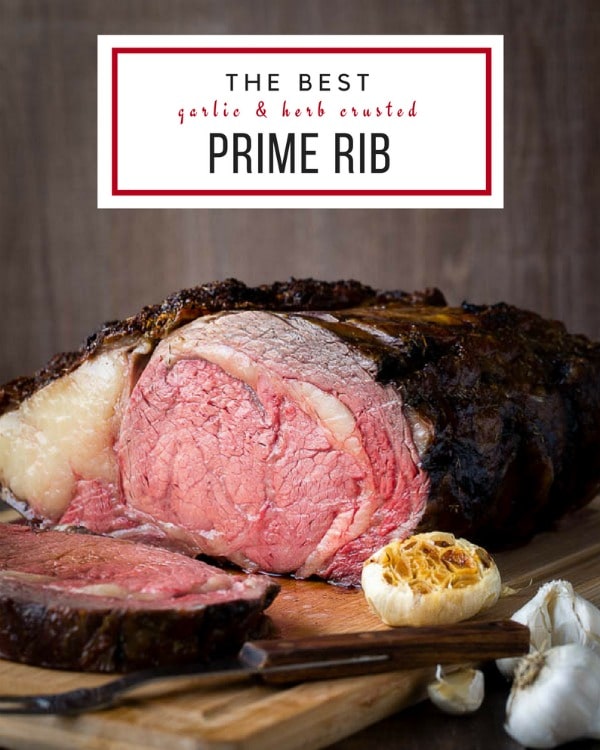
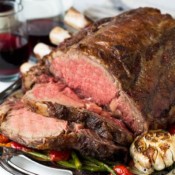
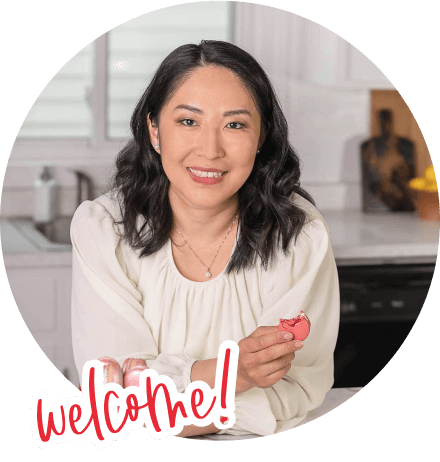
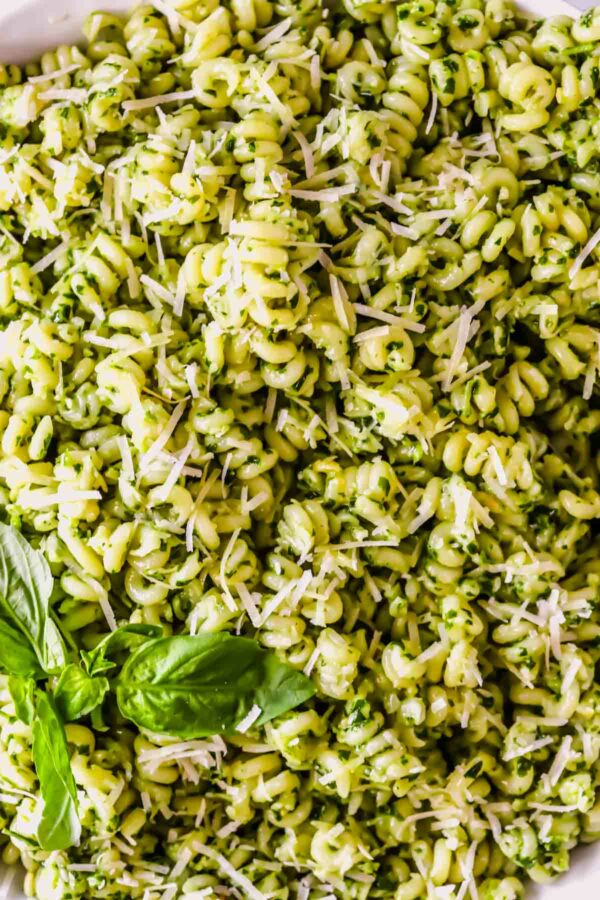
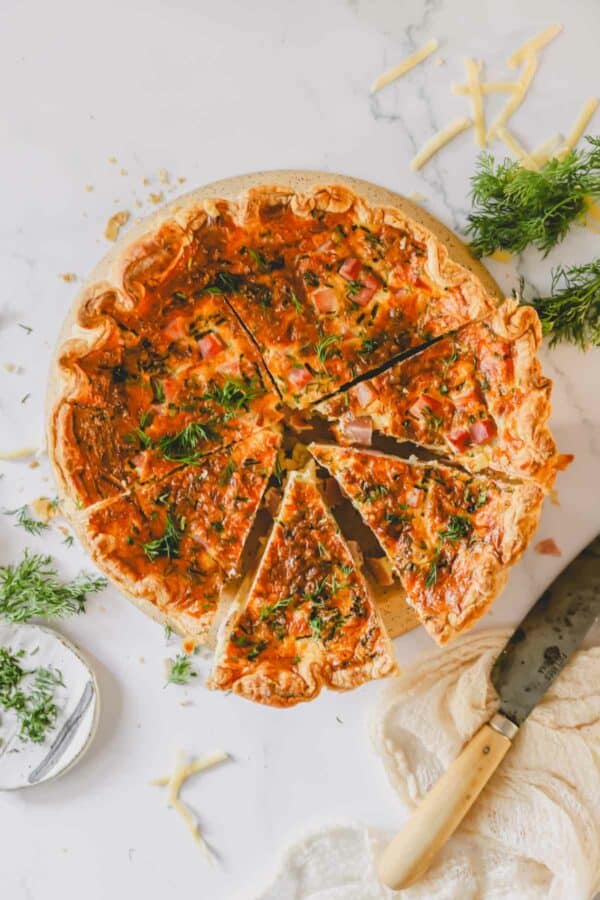
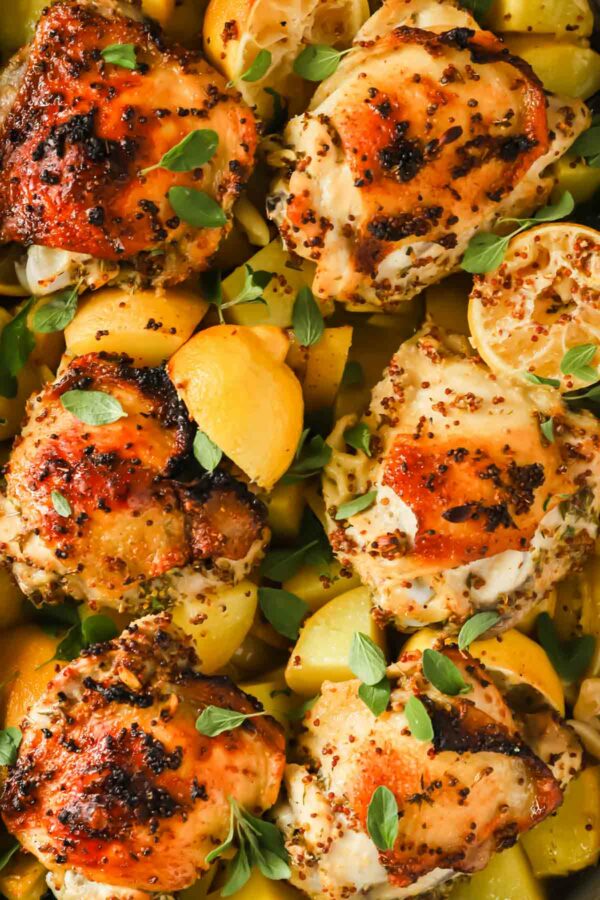
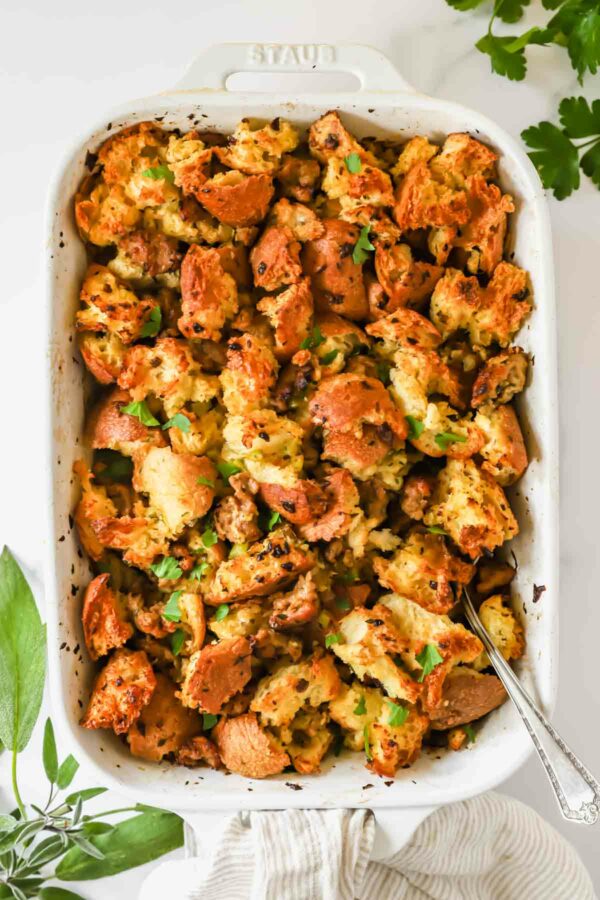

I made this in my convection oven it was fantastic cooked to perfection
Yay, so happy to hear that. Thanks for your feedback, Carol!
It worked! Placed 14 lb. roast in oven at 200 for about 4 hours. Took it out when it hit 125…went up to about 135 over the next hour…came out perfect and the bones fell off without a knife involved. A real relief for such an investment.
Yay, so, so happy you had a perfect result!! Thank you so much for your feedback, Neil!
Followed the directions except omitted the cumin. All I can say is… you delivered on your promise. Came out juicy, flavorful and perfectly done. My son even said, “You did good mom.”
Yay, that’s so good to hear! Thank you for your feedback, Keala!
This will be my 3rd year using this recipe. It’s foolproof! I was very nervous to attempt making prime rib ( definitely don’t want to ruin a beautiful piece of meat). Everyone loved it!
Must agree, however based on my oven/professional experience (my oven is not as good as my commercial/work ovens are), I increased the temp to 250, let rest the 30 minutes uncovered (perfect amount of time to roast our brussel sprouts in between), and let roast for 8 minutes and rest another 20 before carving. I used the same method (shorter slow cook time, same high roast time) for a boneless leg of lamb also being served. Both came out medium rare. Perfect to be gifted and reheated for some, and served for us rare lovers immediately.
I have to agree with Melissa. And I wished I have read her comment earlier!
Our roast came out perfect but not without some heart attacks, time delays and modifications.
We cooked a 3 lbs bone-in prime rib in a countertop oven at 200°F for 2 hours and 20 minutes and let it rest in the oven for 30 minutes.
Note: Our countertop oven is already on the bigger side, has a convection function and it even has a rotisserie spit. (Not your toaster oven.)
At this point, although it has browned, it was still very squishy by touch (via tongs). And the fat cap has not rendered at all.
Then – we seared it on the stove in a wok because our oven doesn’t go up to 500°F for about 30 seconds per side. The curve surface also worked well with the shape of the roast.
We then roasted it for another 1 hour at 275°F. The fat cap in the roast that was closest to the top heating element have rendered out a pool of grease and the oil was bubbling. Crispy shell also formed but only at the point closest to the heating element.
We probably should have started at the higher 250°F.
Finally, the dinner was served at 11pm but yum! Will definitely do it this way again for this $50 worth of meat. Definitely buy a bottle of horseradish to go with.
Have you tried this recipe with a boneless rib roast? I’m going to be cooking a 5lb. boneless prime cut that’s been dry aging for 6 days and love the slow cook/reverse sear approach for your recipe, but also need to ensure I don’t overcook it.
Thanks and Merry Christmas
Yes, I have, and it works the same. Here’s my boneless prime rib version.
Thanks so much – I’ll let you know how it turns out!
Hi, i will try this recipe today. What oven setting would you recommend? Bake, convection bake, or convection roast?
I’m just trying this for the first time right now, and I had a question actually. What if you have two ovens so that I could be heating the other one to 500 while it’s still cooking at 200. Does it need the rest time?
yes the rest time allows the juices to distribute evenly and also bring the inside slightly warmer while cooling the outside. Always let your meat rest.
Yes, you should rest it before the final sear for at least 30 minutes.
I have a 13lb bone-in roast. At 225 degrees about how long will it take to get to rare (I assume I should take out of oven when it reads 115). Thanks.
I’d estimate 3 hours to reach 115lbs at 225°F. And yes, aim for 115°F for rare finish.
I’m laughing because I’m constantly reading Kengi’s book and see you reference it directly- so we must be on to something! I’ve never done it this way but it’s going to be done tonight!
Oh, I love Kenji’s explanations and testing, and this method is definitely a game-changer!! Hope you’ll enjoy it!
This method works every time ! I am no longer afraid to purchase this expensive cut of meat . Thanks
That’s so great to hear, Catherine. Thanks for sharing your feedback. Merry Christmas!
Looking forward to trying this recipe for the first time this Christmas. I do not have a double oven however, and am trying to figure out how to get bread and roast ready at the same time. Can the roast rest again after the final time at 500 degrees? If so, would you tent again and how long would it stay warm? Thank you.
Hi, Kathi! I don’t have a double oven, and I usually bake things while roast is resting before the final sear. (You can rest the roast for 1-2 hours, tented, before searing.) Works out just fine. And yes, you can rest the roast after the final sear as well. Not sure how long it would stay warm though, the longest we’ve waited was 30min. Hope you’ll enjoy, and please let us know how it turns out!